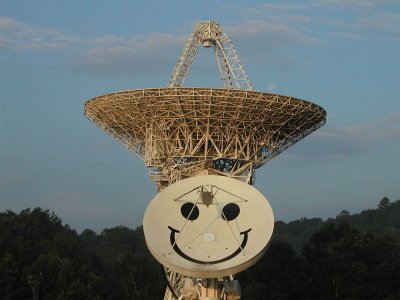Pisgah Astronomical Research Institute
Pisgah Astronomical Research Institute (PARI) (pronounced Perry) is an astronomical observatory located in the United States in Balsam Grove, North Carolina. It is operated as a not-for-profit foundation. PARI is in the Pisgah National Forest of Western North Carolina at an elevation of 914 m (3,000 ft). The observatory is affiliated with the University of North Carolina system through the Pisgah Astronomical Research and Science Educational Center (PARSEC) and also hosts research and study programs with Furman University, Clemson University, Virginia Tech, South Carolina State University and Duke University. PARI operates multiple radio telescopes and optical telescopes for research and teaching purposes. The foundation also sponsors astronomy educational programs using the portable StarLab planetarium. This program has been presented to over 40,000 people of all ages in Western North Carolina.

PARI is home to the Astronomical Photographic Data Archive(APDA) a site to help preserve astronomical photographic plates. These plates were the primary recording medium for astronomy data from the late 1800s until the 1980s. It is estimated that over two million of these invaluable plates exist in astronomy facilities around the world and are in jeopardy of being destroyed because of a lack of storage facilities.
General information
| Pisgah Astronomical Research Institute | |
| Organization | Not-for-Profit Foundation |
| Location | Balsam Grove, North Carolina, United States |
| Coordinates | 35°11′59″N 82°52′21″W / 35.1996°N 82.8724°W |
| Altitude | 914 m (2985 to 3070 ft) |
| Web page | http://www.pari.edu/ |
| Optical Telescopes | |
| Solar Telescope | Coronado Solarmax 40 |
| Polaris Telescope | 12 inch Cassegrain |
| SPACE Telescope | 10 inch Cassegrain |
| Furman / PARI Telescope | 0.35 meter Cassegrain |
| PARSEC Telescope | 16 inch Cassegrain |
| Radio Telescopes | |
| 26 meter East | 327 MHz for Pulsar research |
| 26 meter West | 1.4 and 4.8 GHz |
| 12 meter | Precision Surface 20 GHz |
| 4.6 meter | Smiley 21 cm (1.42 GHz) |
| Sun / Jupiter Array | Automated tracking at 17 to 30 MHz |
| Eight Meter Transient Array | Joint Virginia Tech / PARI project |
PARI is located at the site of the former Rosman Satellite Tracking Station founded by the National Aeronautics and Space Administration (NASA) in 1962. The site was part of the worldwide Spacecraft Tracking and Data Acquisition Network and an integral communications link for Project Gemini, and Project Apollo - the manned space programs. The facility was transferred from NASA to the National Security Agency (NSA) in 1981 and was used as an intelligence gathering facility for the United States. The site was officially closed by the NSA in 1995 and turned over to the United States Forest Service. After several years of inactivity, the government proposed to dismantle the facility. Recognizing the potential future use of this site a small group of interested scientists and businessmen formed a not-for-profit foundation and was able to acquire the site in January 1999. Capital investment continues allowing updates of the equipment for astronomical purposed and maintaining a staff of professional astronomers, engineers, and other scientists. 'Friends of PARI' helps support the educational and research goals of PARI.
The principal radio research instruments at PARI are two 26 meter radio telescopes and a 4.6 meter radio telescope named Smiley. These have been adapted for precision tracking of celestial radio sources using multiple frequencies. Smiley is used for remote classroom teaching of astronomy by students in the US and worldwide. Smiley was given its pleasant face around 1982 as a greeting to overflying foreign surveillance satellites.
The PARI site has hosted several professional astronomy meetings including The Small Radio Telescope Conference in August 2001, and the Gamma-Ray Bursts Today and Tomorrow Conference in August 2002. PARI hosts several educational opportunities, including the Duke University Talent Identification Program.

See also
External links
- Pisgah Astronomical Research Institute (PARI)
- Pisgah Astronomical Research and Science Education Center (PARSEC)
- University of North Carolina Astronomy and Astrophysics
- Furman / PARI Telescope Project
- Virginia Tech Eight Meter Transient Array
- Duke University Talent Identification Program
- Clemson University Department of Physics & Astronomy
- South Carolina State University PARI program
- National Radio Astronomy Observatory
General references
- Goldman, Stuart J. "Mission Possible: The Promise of Pisgah." Sky and Telescope Magazine. October 2001:42
- Hargreaves, Lynley. "Spy Station Retooled into Astronomy Institute." Physics Today. March 2001 Volume 54, Number 3
